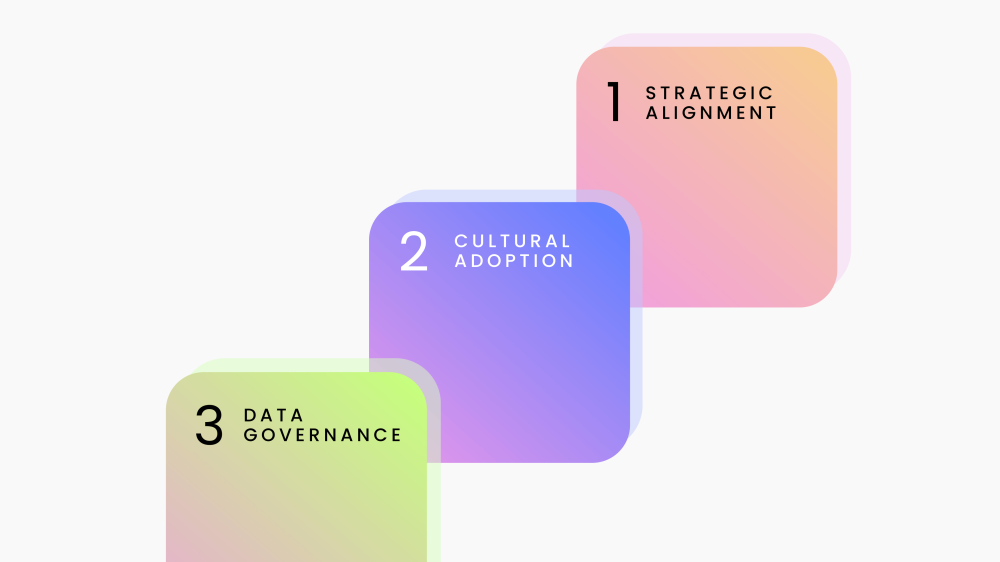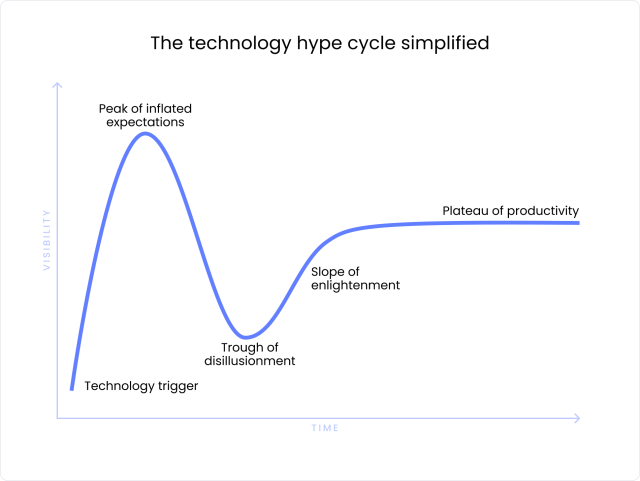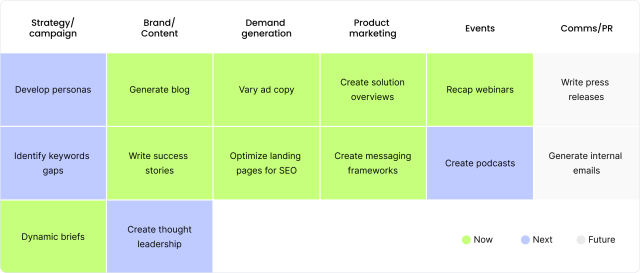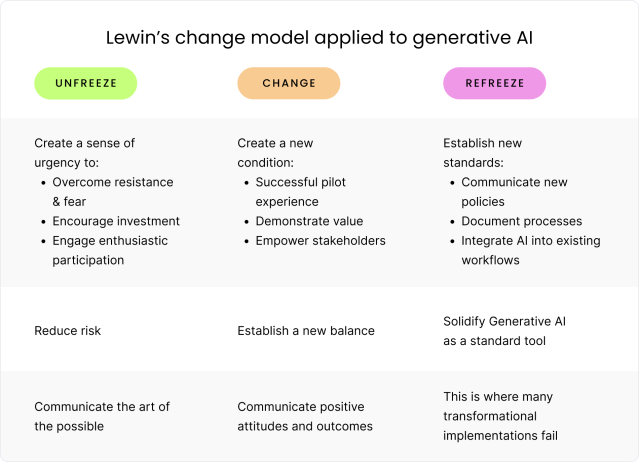Enterprise transformation
– 14 min read
From friction to function
How to conquer the top three barriers to enterprise AI adoption

Picture this: You’re a leader at a Fortune 500 company, wondering what happened to your generative AI initiative. Six months ago, you were brimming with excitement as you pitched the project to your CEO and executive sponsors. You envisioned a transformation in your creative content generation process, with AI tools handling 80% of the initial drafting, freeing up your creatives for strategic thinking, refinement, and innovative campaigns.
But the project has run out of steam and support, and the results are far from what you expected. Instead of the promised wins, your team has stopped using the AI tool. People are back to manual processes and the Chief Data Officer has shut down access for testing. The AI enthusiasts lose their excitement, and the AI skeptics feel validated.
This is the harsh, but common reality many organizations are experiencing while stuck in “proof-of-concept purgatory” as they struggle to scale generative AI and realize the promises of business transformation. Generative AI, like other disruptive technologies is following Gartner’s ‘hype cycle.’ It’s moving from inflated expectations in the short term into the challenges of the trough of disillusionment before reaching sustainable and scaled productivity benefits in the long term.
Sounds bleak? Don’t panic! The good news: the same way cloud computing, mobile technology or big data now deliver widespread value as mainstream parts of business and consumer technology, Generative AI will too. But only if we remember that the success strategies for these past transformation efforts still apply.
- Many organizations are excited about the potential of AI but struggle to integrate these technologies effectively, often getting stuck in “proof-of-concept purgatory.”
- The success of AI in business hinges not just on the technology itself but also on how well humans and organizations adapt to it, focusing on overcoming key obstacles to maximize outcomes.
- Strategic alignment is crucial — AI initiatives must be integrated with business goals to avoid being mere tech experiments and to solve real business problems.
- Creating a culture that understands and embraces generative AI is essential, involving resetting attitudes, engaging stakeholders, and fostering a supportive environment for change.
- Strong data governance frameworks are necessary to ensure AI systems are reliable, secure, and compliant, supporting scalable and effective AI solutions.
- Thinking horizontally about workflows and choosing AI platforms that support broad business functions can enhance operational efficiency and customer engagement, positioning AI as a strategic technology rather than just a productivity tool.
In the excitement around that moment when everyday users got Chat GPT-3, we thought we could skip a few steps on this journey to productivity. But the sustained success of Generative AI in business depends not just on revolutionary technology. It also depends on how seamlessly humans and organizations adapt to the technology. When organizations focus on the most critical obstacles on the road to business transformation, the chances of great outcomes are greatly increased.
These barriers include:
- Aligning generative AI projects with business goals
- Creating a culture that understands generative AI
- Establishing strong data governance frameworks

1. Strategic alignment: moving beyond the hype
Many organizations find themselves captivated by the potential of AI but fail to integrate these projects with their broader strategic goals. Without this crucial integration, AI initiatives risk being flashy tech experiments rather than transformative business tools.
I remember a team spending months working out how to produce AI-generated training videos. The initial results were clunky. The quality of the AI-generated videos just wasn’t close to the team’s standard. But the miss on this wasn’t the lack of quality — it was that the team only needed to produce five training videos per year. Even if the five AI-generated videos were Academy Award-winning, the net result wouldn’t have been a strategic win.
Solving problems that aren’t really problems not only saps valuable resources, but it may also curb enthusiasm for future investments, causing companies to fall behind in the competitive race.
To overcome this hurdle, it’s essential for organizations to ground their AI endeavors with their strategic goals. This means pinpointing where AI can create real business value and establishing clear, measurable objectives that resonate with strategic ambitions.
Think horizontally about workflows
When selecting an AI platform, choose an AI platform that supports broad, horizontal workflows across various functions, not just a single narrow application. A scalable platform should improve the entire value chain, from customer support to operational efficiency.
For example, in a customer support department, instead of just using AI for automated responses, consider how AI can improve the overall customer support strategy in measurable ways.
A comprehensive solution like WRITER can support diverse use cases in a unified manner, built on a central data source, including:
- Managing high-volume inquiry periods: Full-stack generative AI can tap into historical data and recommend high-performing predictive and automated responses. Plus, you can use AI to build comprehensive FAQ sections that translate product knowledge into layperson terms and generate the output in a very specific format.
- Identifying and addressing customer pain points: A full-stack generative AI solution that connects with your customer review data can analyze feedback to spot patterns. You can also build chat applications for instant data access to gain insight into customer sentiment in the moment.
- Tailoring help center assets to fit customer needs: Generate custom support articles using company-specific data, ensuring relevance and compliance with your company standards.
This positions AI as a strategic technology in customer support rather than just a productivity tool.
Create a heatmap of opportunity — not just a proof of concept
Trying to address all these opportunities at once, is not very practical and could end up with teams tripping over each other. Instead, creating a strategic heat map outlining opportunities for now, next, and future at the outset, can ensure a cohesive and thoughtful approach that scales. This method allows individual projects to complement one another, cumulatively building towards substantial business value, getting out of the proof-of-concept trap.

Learn more about use case mapping for AI: How enterprise companies can map generative AI use cases for fast, safe implementation.
2. Cultural adoption: Navigating the trough of disillusionment
After the initial hype surrounding transformational technologies, many organizations enter the “trough of disillusionment,” where the reality of implementation challenges sets in. Cultural resistance is a common issue during this phase. Employees may resist AI due to fears of job displacement or simply due to a lack of understanding of how AI can be an asset rather than a threat.
Thoughtful change management is essential
Building a culture that embraces AI with a lens of curiosity and sanctioned experimentation is crucial to overcoming this friction point.
Lewin’s Three-Step Change Model gives a basic way to think about the change management process as organizations start to deal with the big changes needed for AI adoption to work.
Step 1: Unfreeze
Initiating change in an organization can often feel like trying to ignite a fire with damp wood—especially when introducing something as transformative as AI. To build traction from a cold start, it’s crucial to prepare the organization thoroughly, ensuring the right conditions for this new technology to take hold and flourish.
This preparation involves several key actions:
- Resetting attitudes and behaviors: Break down existing prejudices and habits that could hinder AI integration. It’s important to address and reshape these attitudes before they become obstacles.
- Communicating benefits and importance: Clearly articulate the advantages of adopting AI. Highlight how AI can drive growth and innovation, and explain the limitations of sticking with manual processes. Emphasize how AI adoption can not only advance the company but also bolster individual careers.
- Engaging stakeholders: Involve everyone from IT staff to end-users. Secure their support by maintaining open lines of communication and encouraging two-way dialogues. This inclusive approach helps build a supportive environment for change.
- Sharing real experiences: Have practitioners who are already using AI share their hands-on experiences. Avoid limiting the discussion to theoretical models presented by tech experts. When actual users share how AI tools have enhanced their workflow, it builds trust and relatability. For instance, in a content creation setting, a senior writer could demonstrate how generative AI helps them quickly draft initial article versions, create related social media content, and campaign copy. This not only saves time but also allows for more creative and strategic thinking. Discussing real-life outcomes and demonstrating the technology in action can spark curiosity and build positive momentum.
- Maintaining consistent messaging: Keep the communication consistent to reduce uncertainty and foster a welcoming attitude towards AI. This helps prevent misinformation and cultivates a sense of excitement and urgency about the benefits of AI.
By effectively “unfreezing” the status quo, you make the organization more adaptable and open to embracing new technologies like AI. This initial step is crucial for smoothing the path for change and setting the stage for successful implementation.
Step 2: Change
Once the organization is prepared and a readiness for change has been established, the next step is to roll out AI initiatives. This phase is critical, and it’s essential to offer thorough support and training to help employees grasp how AI can improve their roles and workflows.
Here’s how you can effectively support this transition:
- Ongoing support and training: Continuously offer training sessions and resources to help employees grasp how AI tools can improve their daily tasks and overall efficiency.
- Encouraging involvement and collaboration: Foster a culture of collaboration by integrating AI into daily workflows. This helps embed AI deeply into the organization’s DNA, making its use routine and beneficial across all levels.
- Pilot experiences: Design and execute successful pilot projects that clearly demonstrate the value of AI. Define what success looks like from the outset and establish benchmarks to measure progress. These pilots not only prove the concept but also build momentum and support for wider implementation.
- Measuring impact and communicating success: Regularly evaluate how AI implementations affect key performance indicators (KPIs). Use these metrics to illustrate the business value of AI. Create and share detailed reports and success stories across the organization to highlight positive outcomes and encourage widespread adoption.
By focusing on these areas, you can ensure that the implementation of AI is smooth and that the organization reaps maximum benefits from these technological advancements.
A successful pilot experience that demonstrates value can significantly empower participants and foster positive attitudes towards AI. It’s a powerful way to build momentum and establish a new normal. When designing and running a pilot, it’s crucial to clearly define what success looks like and which benchmarks will be assessed. Hands-on testing of use cases ensures that the business value of the results is tangible, turning participants into frontline evangelists.
Measure your use cases and compare KPIs for manual processes against those enabled by AI. This will highlight the enhancements AI brings to your operations.
Finally, create compelling artifacts that can be shared across the enterprise to communicate the business value of these outcomes. Let the numbers speak for themselves, illustrating the success and potential of AI integration.
Step 3: Refreeze
This phase is key to successful AI adoption and can be the most transformative. After testing and introducing new AI systems, it’s vital to cement the new culture and practices to make AI an integral part of the organization. This means weaving AI into the fabric of everyday operations — incorporating it into reward systems, performance goals, job roles, and workflows, making it the new standard.
Here’s what this looks like in practical terms:
- Redesigning roles and workflows: Adapt and innovate roles and workflows to incorporate AI-driven insights. Create positions focused on AI, such as an AI Program Director, who’ll champion the integration of AI across various functions.
- Revamping performance Management: Update performance management systems to reflect new, technology-driven goals. Set objectives that not only encourage the use of AI tools, but also celebrate the milestones achieved through technological advancements.
- Ongoing training and cultural reinforcement: Continuously offer training and foster a culture that celebrates innovation and the people driving it. This approach helps ensure AI adoption is enduring and that every team member feels valued and part of this transformative journey.
- Encouraging innovation: Inspire employees to explore new use cases for AI, share their success stories, and recognize their innovative efforts. This practice helps make AI a cherished and integral part of the organizational culture.
For a dose of inspiration on how to democratize AI skills, look at how Vizient used champions to foster innovation. By focusing on these key areas during the refreeze phase, your organization can make generative AI a lasting part of your operational landscape, moving beyond just the initial excitement of new technology.

3. Data governance: Laying the foundation for the plateau of productivity
Reaching the “plateau of productivity” with AI means having a rock-solid data governance system in place. In a nutshell, this involves managing how data is used, making sure it’s available, usable, reliable, and secure in your systems, all according to your own rules and policies.
Without strong data governance, even the best-funded AI projects can stumble over issues like poor data quality, limited access, and privacy worries. This foundation isn’t just about keeping things running smoothly — it’s key to building lasting business value and ensuring your AI projects grow successfully without hitting a wall.
Choosing the right platform: How it handles your data
When it comes to data governance, it’s not just your own organization’s practices you need to worry about — it’s also how the AI platforms you use manage and train their models. Choosing the right generative AI platform is crucial, and it’s important to understand how your data will be treated. Keep in mind, all platforms are not built the same. Some might prioritize innovation at the expense of data security, while others may focus so much on compliance that they lose flexibility.
For tips on how to start evaluating potential AI vendors, take a look at “How to evaluate LLM and generative AI vendors for enterprise solutions.” The platform you choose can significantly impact your operations, so it’s essential to select one that aligns with your organization’s data governance policies.
The regulatory reality check: Navigating compliance in a complex world
In today’s regulatory environment, organizations must contend with a dizzying array of laws and regulations governing data usage. From GDPR to HIPAA, the stakes are high, and the consequences of non-compliance can be severe. Developing data governance policies that meet these regulatory demands is crucial, but it’s not just about checking boxes. It’s about creating a culture of data responsibility that permeates every level of the organization.
And let’s not forget partners and vendors. By proxy, they are representing you, your data and your brand. There’s not much point having clear disclosure guidelines for AI generated content, if you don’t know what platforms your creative agencies are using, or what of the content they send back to you is AI generated.
The human factor: Why data literacy matters
Data governance is not just a technical issue; it’s a human one. When employees understand the importance of data governance and are equipped with the skills to manage and input data effectively, they become the guardians of AI success. By cultivating a culture of data literacy, organizations can ensure that their AI systems are built on a foundation of trust, accuracy, and reliability. By acknowledging the critical role of data governance, organizations can unlock the full potential of generative AI and drive meaningful innovation. It’s not just about technology; it’s about creating a culture of data responsibility that supports the entire organization.
So let’s keep going.
The future beckons with the promise of generative AI, a journey marked not by ease but by transformative potential. As we navigate through the typical ‘hype cycle’ of inflated expectations and subsequent disillusionment, the true path to success lies in steadfast commitment and strategic foresight.
By aligning our AI initiatives with core business objectives, cultivating a culture attuned to the nuances of AI, and establishing robust data governance, we can turn potential into performance. This isn’t just a technological shift but a strategic revolution. Let’s embrace this challenge, not as a hurdle but as an opportunity to lead and innovate.
The journey from friction to function may not be easy, but it’s one worth taking.
ABOUT THE AUTHOR
Camilla Sullivan is the Managing Principal at Navigaite, where she serves as a trusted advisor to clients seeking to adopt and integrate generative AI. With over 25 years of experience in content creation, brand strategy, and organizational change management, Camilla is known for developing strategies that drive both creative outcomes and business results. She works closely with brands to ensure a seamless adoption of AI technologies, empowering teams, while enhancing operational efficiency. Camilla works at the intersection of creativity and technology, helping brands unlock the new possibilities of generative AI, through a human-centered approach.
